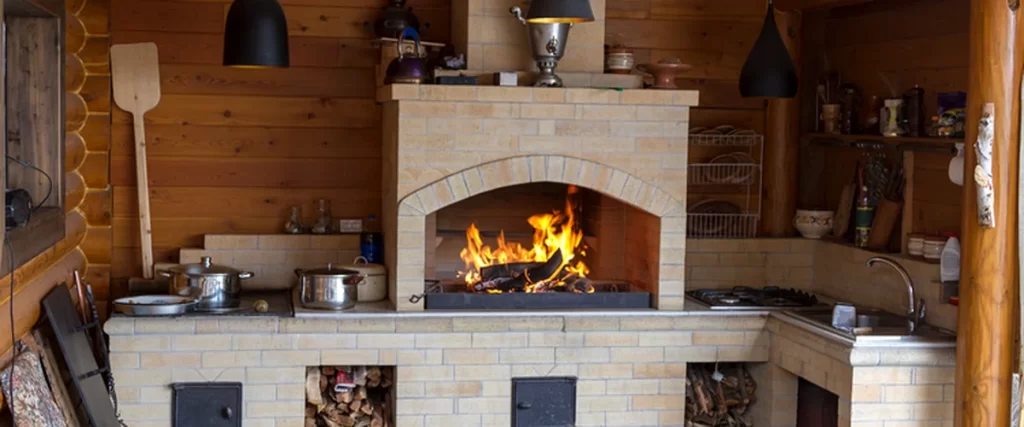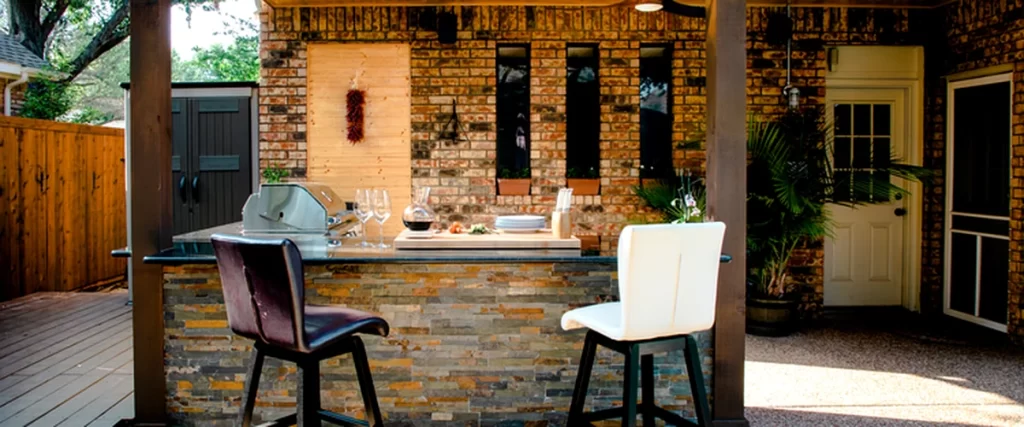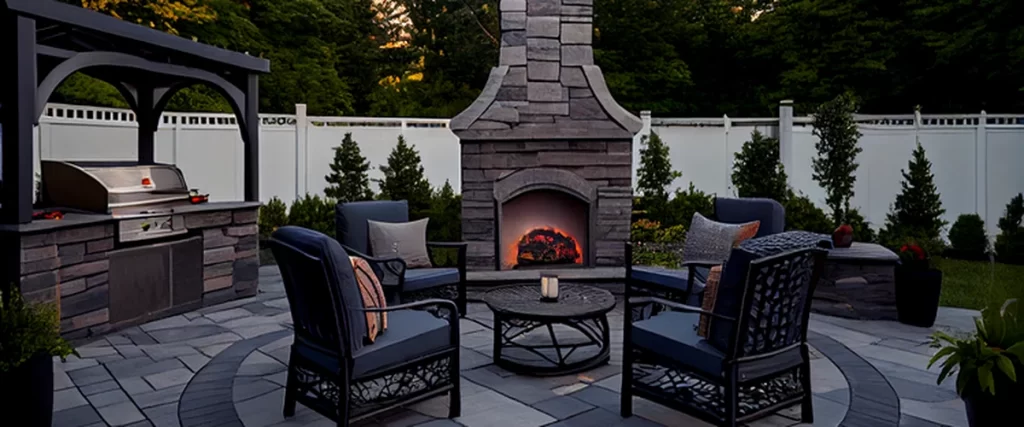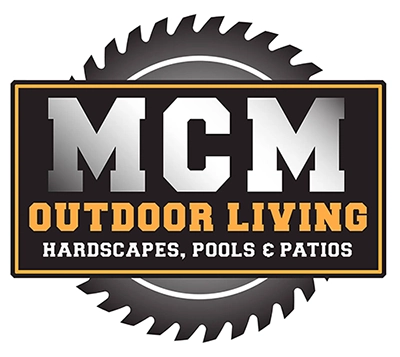As the weather cools and the evenings grow shorter, your backyard might not see as much activity as it did during summer cookouts. But even if the outdoor kitchen goes quiet for a few months, it still needs care. Preparing it for colder weather ensures it stays in great shape and ready for use again when spring returns.
Knowing how to winterize an outdoor kitchen is especially important in areas where temperatures drop near or below freezing. Even a mild Texas winter can cause damage if water remains in pipes or if appliances are left exposed to the elements.
Taking a little time now to protect your outdoor kitchen can save you expensive repairs later and keep your appliances, cabinets, and surfaces looking new year after year.

Why Winterizing Matters
An outdoor kitchen faces challenges your indoor kitchen never will: fluctuating temperatures, moisture, and exposure to rain or snow. When water freezes, it expands, which can crack plumbing lines, faucets, and fittings. Prolonged exposure to cold can also damage outdoor appliances and cause rust on metal surfaces.
Winterizing protects your investment. It prevents pipes from bursting, blocks moisture from seeping into cabinets, and keeps surfaces from cracking. Whether your space includes a gas grill, outdoor fridge, or stainless steel cabinets, a proper winter prep routine helps ensure everything is ready when warm weather returns.
Step 1: Shut Off Water and Drain All Lines
Start with your water supply. Any line that holds water is at risk of freezing, so make sure to drain it completely.
- Turn off the water valves that supply the outdoor sink, fridge, and ice maker.
- Open the faucets to let any remaining water flow out.
- If your system has drain valves or a p-trap, empty them as well to prevent trapped water from freezing.
Blowing compressed air through the supply lines helps remove excess water, especially for outdoor faucets or longer pipe runs. If your outdoor kitchen sink connects directly to your home’s plumbing, consider having a plumber help you drain and shut off those lines correctly.
Step 2: Disconnect and Clean Appliances
Outdoor appliances should be cleaned and disconnected for the season. Each type has its own needs, but most follow a similar process.
Gas Grill
Clean the outdoor grill thoroughly. Remove food residue and grease from grates and burners. Use a soft brush or mild soap and water, and once dry, apply a thin layer of cooking oil to the metal surfaces to prevent rust.
If your grill connects to a gas line, shut the valve completely. For propane tanks, disconnect them and store them in a dry, ventilated area away from direct sunlight or open flames. Finally, cover the grill with a durable grill cover for extra protection against rain or frost.
Refrigerator and Ice Maker
Your outdoor fridge and ice maker need attention before freezing temperatures arrive.
- Unplug both units and empty all food or ice.
- Wipe down the interior with mild soap and water to prevent mildew.
- Leave the doors slightly open so air can circulate inside and moisture doesn’t get trapped.
Disconnect and drain any water lines running to the fridge or ice maker. Excess water inside the tubes can freeze and damage components.
Other Appliances
For pizza ovens, side burners, or warming drawers, clean all cooking surfaces and check for grease buildup. Remove debris and cover them once dry. Anything that runs on electricity or gas should be disconnected or switched off completely.
Step 3: Protect the Plumbing and Sink
Outdoor sinks, faucets, and connected pipes need special attention because water tends to linger in the bends of plumbing lines.
- Drain the sink completely and leave the faucet open after the water is shut off.
- Remove and store any hoses attached to the faucet.
- If the sink connects to a p-trap, make sure it’s emptied. You can pour a small amount of RV antifreeze into the trap to block any residual water from freezing.
Clean the outdoor kitchen sink with mild soap, rinse it well, and dry it fully. This prevents mineral buildup and keeps the surface looking fresh.
Step 4: Clean and Protect Stainless Steel Surfaces
Many outdoor kitchens feature stainless steel cabinets, appliances, and counters. Stainless steel is known for its durability, but exposure to moisture and winter air can still lead to corrosion or dull spots.
Before winter sets in:
- Clean stainless steel surfaces with warm water and mild soap.
- Dry thoroughly with a soft cloth.
- Apply a thin coat of stainless steel polish to create a protective barrier against rust and moisture.
For powder-coated or painted cabinets, wipe them down with a damp cloth, then dry completely. If your cabinets have a powder coat finish, make sure no dirt or grime remains, as buildup can wear down the finish over time.
Closing all cabinet doors tightly helps keep out snow, insects, and debris.
Step 5: Seal Countertops and Surfaces
Countertops face constant exposure to outdoor elements like rain, UV rays, and fluctuating temperatures. Natural stone materials such as granite or concrete should be sealed properly before winter to block moisture and staining.
Clean the surface with mild soap and water, allow it to dry, and apply a weather-appropriate sealer. This helps prevent cracks that can form from trapped water expanding during freezing temperatures.
For tile countertops, inspect grout lines and reseal if they appear worn. Any small gap can allow water to enter and freeze, leading to long-term damage.

Step 6: Cover and Store What You Can
Outdoor kitchens are made to withstand outdoor conditions, but a little extra protection goes a long way. Use high-quality covers on grills, sinks, and built-in appliances. Look for materials that are breathable yet water-resistant to prevent condensation.
If you have outdoor furniture nearby, clean it, let it dry, and store it in a garage or shed. Cushions should be kept indoors to prevent mold and mildew.
For any smaller or removable items like utensils, cutting boards, portable burners, store them inside until spring. It reduces clutter and keeps everything in good condition for the next season.
Step 7: Inspect Electrical and Gas Connections
Before closing up your outdoor kitchen for the season, double-check all electrical outlets, appliances, and gas lines. Make sure connections are clean and secure, and turn off all power sources to prevent short circuits during damp or freezing conditions.
Covering electrical outlets with weatherproof covers protects them from moisture and corrosion. If you have fire pits or built-in gas features, inspect the lines for leaks or damage.
A quick inspection now helps ensure everything will work smoothly when you start using your outdoor space again.
Step 8: Give Everything a Final Clean
Before your outdoor kitchen rests for the winter months, finish with a thorough cleaning.
- Wipe down countertops, appliances, and cabinets.
- Sweep the floors and remove any food crumbs or grease that might attract pests.
- Dispose of leftover charcoal, ash, or wood from grills or fire features.
Leaving the space clean prevents unwanted odors, rust, and stains. It also means less work when spring comes. Your outdoor kitchen will be nearly ready to use again.
Step 9: Add Extra Protection if Needed
If your area experiences freezing temperatures for an extended period, consider adding a few extra protective steps.
- Place weatherproof mats or covers on countertops for insulation.
- Use silicone caulk to seal small gaps between cabinets and walls.
- Move fragile or decorative items indoors to avoid cracks or discoloration from cold air.
Even in mild climates, a few layers of protection help extend the lifespan of your entire outdoor kitchen.
Step 10: Check Everything Before Spring
When the weather warms up again, inspect all components before turning on the water or gas supply. Look for signs of rust, leaks, or cracks, especially around plumbing lines. Test each appliance gradually and let everything dry out completely before full use.
Taking time to inspect and recondition the space after winter ensures a smooth transition back into an outdoor cooking season.

Keep Your Outdoor Kitchen Ready Year-Round
Learning how to winterize an outdoor kitchen helps protect every part of your investment, from the stainless steel cabinets to the outdoor sink and gas grill. A few hours of preparation before temperatures drop can save you from costly damage later.
Still, every outdoor kitchen is different. Layout, materials, and local weather patterns affect what kind of maintenance it needs. Sometimes it’s easier and safer to have professionals handle the process, especially when dealing with plumbing, gas, or electrical systems.
At MCM Outdoor Living, we design, build, and maintain outdoor kitchens made to last through every Texas season.
If you’d rather enjoy your backyard instead of worrying about seasonal maintenance, call us at (469) 583-6213 or message us here. Our team will make sure your outdoor kitchen stays protected, polished, and ready for use all year long.
